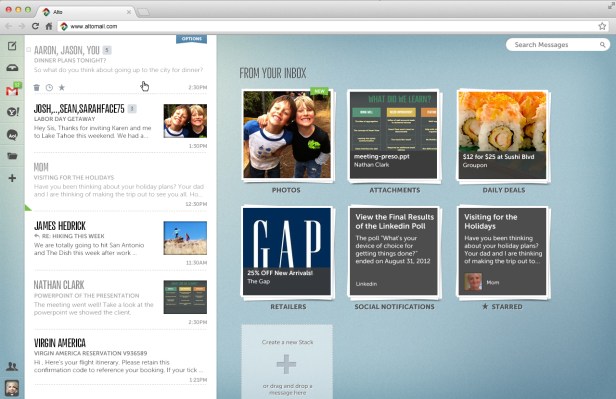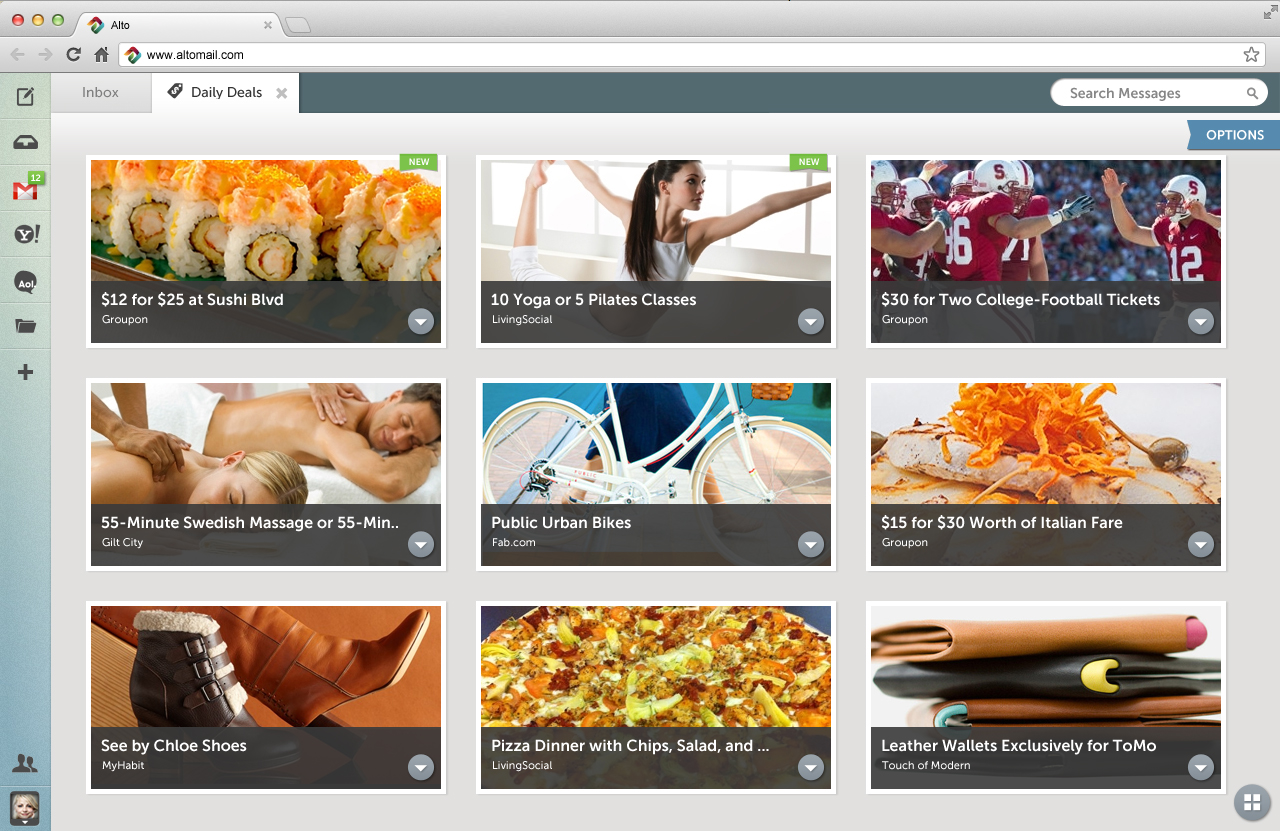The way we use email has changed dramatically in the past decade-plus — written down like that, it seems like an almost laughably obvious statement. But David Temkin, AOL’s senior vice president of mail and mobile, argues that email clients haven’t kept up with the changes — with the last major innovation coming in 2004, when Gmail launched.
Given its age, and its association with the early, “You’ve got mail!” days of email, AOL (which owns TechCrunch) might not seem like an obvious candidate to do anything innovative in this area. However, the company isn’t just bolting on some new features to the existing AOL Mail product. Instead, it’s launching an entirely new webmail client called Alto, which is being gradually rolled out in a limited preview starting today.
According to Temkin and Josh Ramirez, senior director of product for AOL Mail and Alto, the new client actually has its roots in an attempt to overhaul AOL Mail. However, it became apparent that any major redesign would falter on the attempt to serve two different audiences — the existing userbase, which isn’t really interested in seeing any dramatic changes, and another group that’s looking for, in Temkin’s words, “a new product intended for and matched to how people use email today.”
The biggest change in Alto versus other email clients is a new concept called Stacks. They basically function as a way to pre-sort your email, so that you’re not stuck reading through daily deals from Groupon and notifications from Facebook when all you really want to do is see if you’ve got a new message from your friends and family. They’re like folders or labels, but managed through an intuitive drag-and-drop interface, and allowing users to decide that they want to make large swaths of their email bypass the main inbox entirely, to be saved in Stacks where they can be read later.
When you first set up an account on Alto, it will create Stacks (assuming there are applicable emails in your inbox) for social notifications, daily deals, and messages from retailers. You’ll also get a Stack that highlights all the photos from all the messages in all your inboxes, and another with all the attachments. You can create new Stacks by just dragging emails into the main dashboard, and you can also customize the rules around each one — namely the specific senders, recipients, or subject lines that signal whether an email belongs in a Stack, and also whether each Stack should skip the inbox or not.
Again, the idea behind Stacks isn’t entirely new (besides its obvious roots in email folders, you could also compare it to efforts like Other Inbox), but the implementation seems smart and intuitive. Ramirez noted that email folders are largely “aspirational” — something that users want to use, but often aren’t able to keep up with. With Alto, a lot of the basic setup is already done for you with the initial Stacks, and it’s also quite easy to create new ones. Once they’re set up, Stacks can just run automatically without any interference, though you can be more hands-on and customize the rules if you want.
“Not an entirely new idea, but well executed” is a description that could be applied to many of the features in Alto. As Temkin and Ramirez demonstrated the product, I was less impressed by any one feature and more by the sense that Alto was built up from lots of smart touches. And with a design that’s driven by images and icons rather than row after row of text, it just looks good — as I kept glancing back-and-forth between the demo screen and my own computer, where Gmail was open in the background, I couldn’t help thinking about how cramped Gmail looked in comparison.
Another important feature is the fact that you won’t need to sign up for a new email address. (“We need another email address like we need a hole in the head,” Temkin said.) Instead, you can use it with your existing email accounts — initially, it’s offering support for Gmail, Yahoo! Mail, AOL, and .Mac mail accounts, and Temkin said it should eventually include any IMAP-based email account.
Other features include a visual search interface with instant results that appear as you type, profiles for contacts that include their latest social network updates, and a slick interface for browsing retail newsletters and daily deals. Ramirez said that last feature is kind of like a TiVo for “bacn“-type content, allowing you to read it later, rather than mixing it in with more personal and important messages. And he argued that Alto, like TiVo, might actually increase the amount of newsletters, deals, and the like that you’re willing to read, because it gives you control over when you consume the content.
Then there’s my favorite feature, an email “snooze” button. As others have observed, for many of us, email has become our default to-do list, unfortunately organized based on who emailed us last, rather than real priority. With the snooze button, you can move an email off the top of your inbox/to-do list, but it returns to the top after a given period of time. Basically, it’s a way of making sure that important emails don’t slip through the cracks, even if you don’t have the time/inclination to deal with them right away.
The current version of Alto hasn’t really been optimized for smartphones or tablets yet, but it already seems to work pretty well on a tablet — Temkin argued that’s because it “almost has a tablet design aesthetic in the first place.”
As for what all this means for AOL Mail, Temkin said the company plans to support both Alto and AOL Mail as different products for different audiences. But if all the cool new stuff is going into Alto, doesn’t that suggest AOL is going to let the older product die, albeit slowly? “Absolutely not,” Temkin said, adding that there’s still a big appetite for “a classic mail experience.”
You can request an invitation to Alto here.

